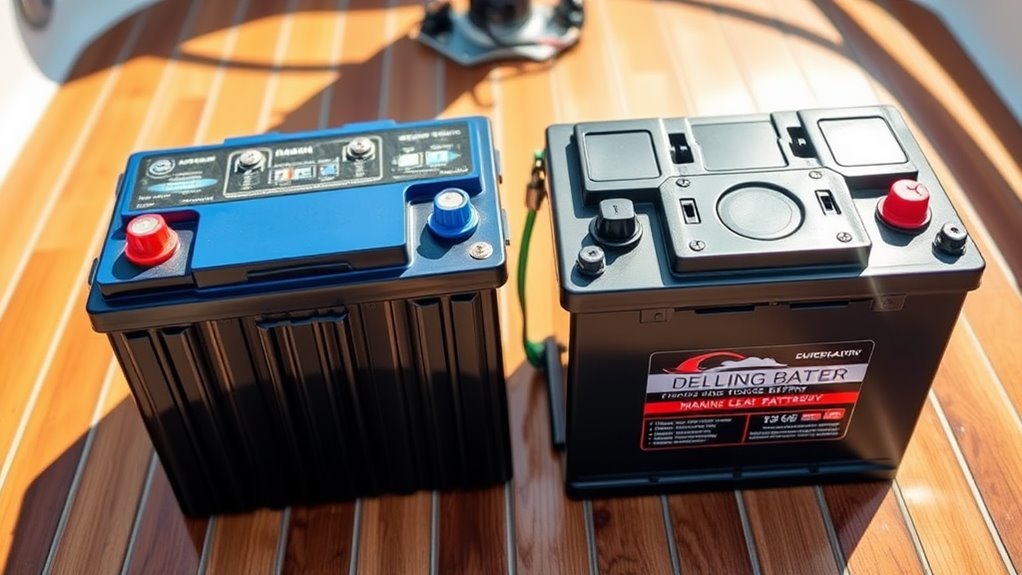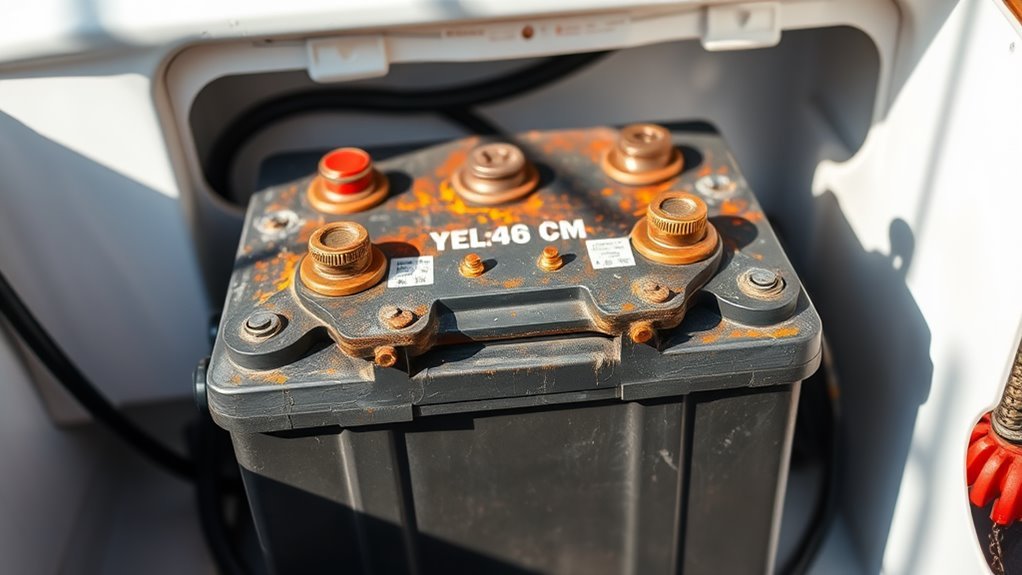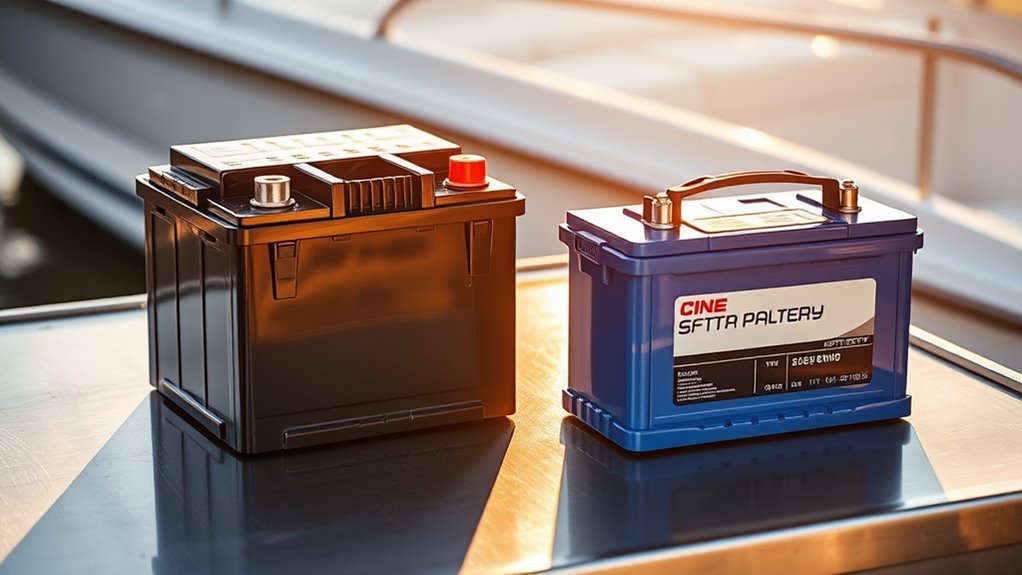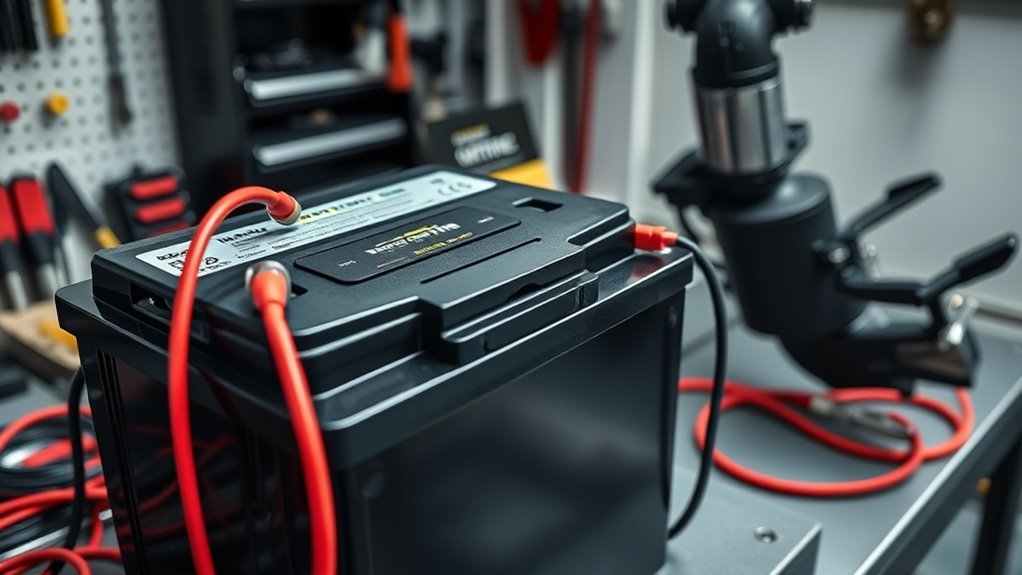Car batteries and trolling motor batteries serve completely different purposes in practice. As a boat mechanic who’s fixed countless electrical issues, I can tell you that using a car battery for your trolling motor is like trying to power your house with a motorcycle battery – it just won’t work well.
Car batteries are designed for quick, powerful bursts of energy to start engines, while trolling motor batteries need to deliver steady power over many hours. The internal construction of these batteries reflects these different roles. Car batteries have thin plates to maximize surface area for those short, intense power bursts. Marine deep cycle batteries have thicker plates built specifically for sustained power delivery.
I’ve seen many fishing trips cut short because someone tried to save money with a car battery. These batteries typically die after just a few hours of trolling motor use, and repeated deep discharging permanently damages them. They also tend to wear out much faster than proper marine batteries, actually costing more in the long run.
From my 20 years of experience working on boats, I recommend investing in a quality deep cycle marine battery. While the upfront cost is higher, you’ll get reliable performance and a much longer lifespan. Quality marine batteries can last 3-5 years with proper care, compared to car batteries that might only last a season when used for trolling.
“A car battery on a trolling motor is penny-wise but pound-foolish. You’ll spend more replacing damaged batteries than if you’d bought the right one from the start.” – A lesson I share with every customer who asks about this shortcut.
Understanding Car Battery vs. Trolling Motor Battery Design

While it’s tempting to use a car battery for your trolling motor, you’re setting yourself up for disappointment.
Let’s break down why these two battery types are fundamentally different beasts.
Car batteries excel at one thing: delivering short, powerful bursts to start engines. That’s it. They’re sprinters, not marathon runners.
Trolling motor batteries, specifically deep cycle batteries, are built with thicker plates designed for sustained power delivery over long periods. They’re the endurance athletes of the battery world.
Think about it: your trolling motor needs steady power for hours on end. A car battery’s thin plates simply can’t handle this kind of sustained discharge.
You’ll destroy its internal structure, and before you know it, you’re shopping for a replacement.
Stick with proper deep cycle batteries rated at least 110 AH. Additionally, using the correct charger for your battery type is crucial for optimal battery performance.
Performance Impact When Using Car Batteries for Trolling
How well does a car battery actually perform with a trolling motor? While you’ll get an initial burst of speed, don’t expect it to last. We’re talking about an hour of hard use – max. That’s not nearly enough for a decent fishing trip.
Here’s the brutal truth: car batteries aren’t built for this kind of abuse. Unlike deep cycle marine batteries, they can’t handle being drained below 50% without taking serious damage. Additionally, the battery capacity influences how long you can run your trolling motor effectively.
External factors like wind and motor load will drain your car battery even faster, leaving you stranded.
Sure, you might save money upfront, but you’ll destroy your car battery in the process. The performance simply isn’t there for sustained trolling motor use.
Trust us – invest in a proper deep cycle marine battery instead.
Battery Life Expectancy and Durability Concerns

If you’re hoping your car battery will survive long-term trolling motor use, we’ve got bad news.
Car batteries simply aren’t built for this kind of punishment, and their battery life expectancy plummets when used for trolling applications.
Here’s the harsh reality: While deep cycle batteries can last 4-6 years with proper care, your car battery will likely give up after just two years of trolling duty.
The durability concerns are serious – discharging below 50% damages the internal plates, and repeated deep discharges accelerate deterioration. Even with perfect maintenance, you’re fighting a losing battle.
Want real trolling performance? Invest in a proper deep cycle battery rated at 110 amp-hours or higher. Higher voltage systems enhance battery efficiency, requiring less current for equivalent power output, making them the only sensible choice for serious trolling use.
Safety Considerations and Risks
Beyond damaging your wallet, using a car battery for trolling motor power creates serious safety hazards you can’t ignore.
When we connect a trolling motor to a car battery, we’re risking catastrophic starter motor failure and potential electrical system damage. The risks multiply on the water – you could find yourself stranded when the battery dies unexpectedly.
Let’s be clear: car batteries aren’t built for deep cycling. Push them below 50% charge, and you’re gambling with both performance and safety.
We’ve seen too many cases where boaters learned this lesson the hard way. The incompatible discharge characteristics between car batteries and trolling motors create a perfect storm of potential failures. Regular battery maintenance is crucial to ensure optimal performance and safety.
It’s not worth compromising your safety or risking equipment damage just to save a few bucks.
Cost Analysis: Car Battery vs. Marine Deep Cycle Battery

The money-saving appeal of using a car battery quickly evaporates when you crunch the real numbers.
While you’ll spend just $100 upfront for a car battery compared to $100-$500 for a deep cycle marine battery, we’re looking at a classic penny-wise, pound-foolish scenario.
Let’s do the cost analysis: Car batteries last 2-3 years max when used for trolling motors – and that’s being optimistic.
You’ll likely replace them even sooner due to rapid deterioration.
Deep cycle batteries, however, soldier on for 3-10 years under the same conditions.
Do the math: Two or three car battery replacements will cost you more than a single quality deep cycle battery, not to mention the hassle of frequent swaps and potential fishing trip interruptions. Additionally, proper battery maintenance is crucial for optimal thrust and performance, further emphasizing the need for a reliable deep cycle option.
Recommended Alternatives for Trolling Motor Power
While car batteries might seem tempting, we’ve got several battle-tested alternatives that’ll serve your trolling motor needs without compromise.
Let’s cut to the chase: Group 27 deep cycle marine batteries are your go-to solution, delivering a solid 110 amp-hours for peak motor performance.
For those ready to invest, LiFePO4 batteries offer game-changing weight reduction and longevity.
Working with a tighter budget? Flooded lead-acid batteries deliver reliable power at around $100, though you’ll need to stay on top of maintenance.
Want a middle-ground option? AGM batteries give you maintenance-free operation and enhanced durability without breaking the bank. Additionally, pairing your trolling motor with deep cycle batteries is essential for optimal performance and longevity.
Maintenance and Charging Requirements

Since you’ve opted to use a car battery for your trolling motor, you’ll need to master some critical maintenance protocols to avoid burning through batteries like cash.
We’ll be straight with you: proper charging is non-negotiable. Never let your battery dip below 50% charge, and recharge immediately after every use. Trust us, deep discharges are battery killers.
Invest in a smart charger – it’s your best defense against overcharging damage and will automatically adjust charge levels. Keep a hawk’s eye on those electrolyte levels too.
Regular maintenance isn’t just a suggestion – it’s your battery’s lifespan insurance policy. When not in use, keep that battery fully charged. Additionally, monitor voltage with a multimeter to ensure your battery remains in optimal condition.
Skip these steps, and you’ll find yourself shopping for replacements way sooner than necessary.
Frequently Asked Questions
Can I Use a Regular Car Battery for Trolling Motor?
While we wouldn’t recommend using car batteries for trolling motor compatibility, their discharge rates aren’t suited for continuous use. We suggest investing in proper marine battery types for reliable performance.
How Long Will a Trolling Motor Last on a Car Battery?
We’ll typically get about one hour of trolling motor lifespan with a car battery, though battery capacity and power usage vary based on conditions like wind, speed settings, and boat weight.
What Kind of Battery Do I Use for a Trolling Motor?
We’ll want deep cycle marine batteries for trolling motors, not car batteries. These specialized batteries deliver steady power over time and, with proper battery maintenance, provide reliable performance for our boating needs.
Can You Use a Regular Car Battery in a Boat?
While you’re sailing through options for boat batteries, we don’t recommend using regular car batteries. They’ll sink your hopes with quick depletion and potential damage. Instead, invest in proper marine deep-cycle batteries.